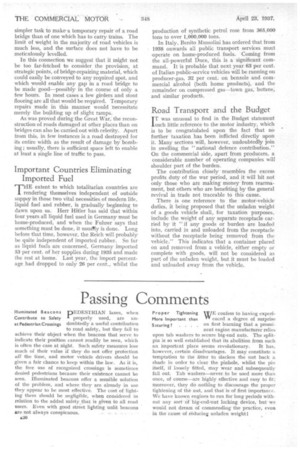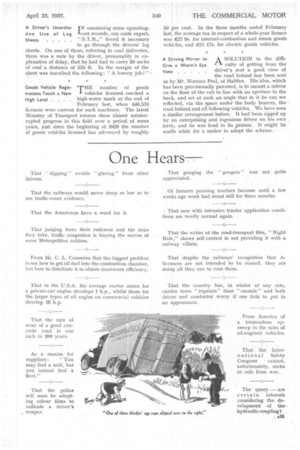Passing Comments
Page 32

Page 33

If you've noticed an error in this article please click here to report it so we can fix it.
Illuminated Beacons DEDESTRIAN lanes, when Contribute to Safety I properly used, are unat Pedestrian Crossings doubtedly a useful contribution to road safety, but they fail to achieve their object when the beacons that serve to indicate their position cannot readily be seen, which is often the case at night. Such safety measures lose much of their value if they do not offer protection ail the time, and motor vehicle drivers should be given a fair chance to keep within the law. As it is, the free use of recognized crossings is sometimes denied pedestrians because their existence cannot he seen. Illuminated beacons offer a sensible solution of the problem, and where they are already in use they appear to be most effective. The cost of lighting them should be negligible, when considered in relation to the added safety that is given to all road users. Even with good street lighting unlit beacons are not always conspicuous, WE confess to having experienced a degree of surprise on first learning that a prominent engine manufacturer relies upon tab washers to secure big-end nuts. The splitpin is so well established that its abolition from such an important place seems revolutionary. It has, however, certain disadvantages. It may constitute a temptation to the fitter to slacken the nut back a shade in order to clear the pinhole, whilst the pin itself, if Loosely fitted, May wear and subsequently fall out. Tab washers—never,to be used more than once, of course—are highly effective and easy to fit; moreover, they do nothing to discourage the proper tightening of the nut, and that is of first importance. We have known engines to run for long periods without any sort of big-end-lint locking device, but we would not dream of commending the practice, even in the cause of r6clucing unladen weight l
Proper Tightening More Important than 5z:curing . . .
A Driver's UnorthoIN examining some operatingd ox Use of Log 'cost records, our costs expert, Sheets " S.T.R.," found it necessary to go through the drivers' log sheets. On one of these, referring to coal deliveries, there was a note by the driver, presumably in explanation of delay, that he had had to carry 30 sacks of coal a distance of 150 ft. In the margin of the sheet was inscribed the following "A lowsey job! " •
Goods Vehide RegisTHE number of goods
trations Touch a New vehicles licensed reached a High Level . . . high-water mark at the end of
February last, when 448,570 licences were current for such machines: The latest Ministry of Transport returns show almost uninterrupted progress in this field over a period of some years, and since the beginning of 1929 the number of goods vehicles licensed has advanced by roughly
50 per cent. In the three months ended February last, the average tax in respect of a whole-year licence was £27 9s. for internal-combustion and steam goods vehicles, and £21 17s. for electric goods vehicles.
A Driving Mirror to A SOLUTION to the diffi
Give a Worm's Eye culty of getting from the ' View driver's seat a good view of
the road behind has been sent us by Mr. Norman Peel, of Halifax. His idea, which has been provisionally patented, is to mount a mirror on the floor of the cab in line with an aperture in the back, and set at such an angle that in it he can see reflected, via the space under the body bearers, the road behind and all following vehicles. We have seen a similar arrangement before. It had been rigged up by an enterprising and ingenious driver on his own lorry, and he was loud in its praises. It might be worth while for a. maker to adopt the scheme.




























































































